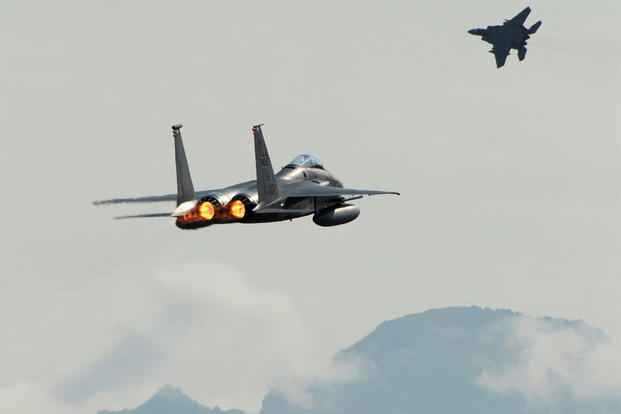The Air Force is looking at possible plans to retire the F-15C/D Eagle as early as the mid-2020s, officials told lawmakers Wednesday.
While the decision would mean divesting an entire aircraft class, officials said the F-15 capability would be replaced by the F-16 Fighting Falcon, a potential cost-saving measure that would allow pilots to train on fewer platforms.
Air National Guard Director Lt. Gen. L. Scott Rice said the Air Force as a total force is in "deep discussions" and will further assess the F-15 inventory next year.
"The F-15C [has] served our nation well, as have its pilots for decades. And it was our air superiority fighter; now F-22 has taken that role," said Maj. Gen. Scott D. West, director of current operations and deputy chief of staff for operations for the service at the Pentagon.
Air Force officials were testifying before the House Armed Services Subcommittee on Readiness on Capitol Hill.
"We do have capacity in the F-16C community to recapitalize that radar to serve the same function as the F-15 has done and thereby reduce the different systems that we have to sustain and operate, so that makes it more efficient," West said about the effort to minimize the number of systems pilots operate.
Taking questions from reporters after the hearing, Rice elaborated, "It's a bigger picture. There's a balance between capability and capacity -- capacity being, do we have … 1,900 to 2,000 fighters in our inventory? But at the same time, we also look at capability. Does it have all the right radar on it [at] the right time? Certainly, an F-15 right now is a very capable platform … [but] as we move into maintaining our capacity and keeping our capability, we have to address those needs."
Rice said "planning choices" for the F-15C within the 2019 budget started last fall.
The F-15 is all-weather, tactical fighter; the now-retired F-15A made its maiden flight in 1972. The single-seat F-15C and two-seat F-15D models entered the Air Force inventory beginning in 1979, and have been in almost every theater across the globe, according to the service.
American F-15s are stationed at overseas bases such as RAF Lakenheath, England, and Kadena Air Base, Japan. A deployment of F-15s moved across Europe last summer as a deterrent for Russia during Operation Atlantic Resolve, and F-15E Strike Eagles have been used throughout the air war against the Islamic State.
Rice said planned F-15 upgrades will be fulfilled. However, the Air Force may want to look at the next block of upgrades to save on future sustainment and operational costs, he said.
Rep. Martha McSally, a former Air Force pilot and advocate for the A-10 Thunderbolt, questioned the choice to scrap the F-15 -- a capable fighter, "the best in air-to-air" as a fourth-generation aircraft.
"The F-16 kind of fills in those gaps, [but] comparing the capabilities side-by-side we have to be careful through that analysis," the Arizona Republican said. "But I realize the funding challenges that you have as you go through this decision process -- but it doesn't bring the same capability."
Rice said he believes the Air Force is getting beyond comparing aircraft platforms "especially in the digital age" when looking at the platforms as systems and "how they integrate is as important and, in the future, will be even more important than the platform itself," he said.
The Air Force wants more manpower, more maintenance, more pilots to ramp up readiness and sustain the force for a high-end fight with a near-peer adversary.
West, Rice and Lt. Gen. Maryanne Miller, chief of the Air Force Reserve, testified they need pilots to sustain each part the force: at least 800 for the Guard; 300 for the Reserve; and nearly 1,500 -- including 700 fighter pilots -- for the active-duty component.
When asked if retiring the F-15 is a good idea amid a push to ramp up pilot -- especially fighter pilot -- production in the next few years, Rice said, "That's true that is a challenge, because it's not just capability-capacity, it's all sorts of things. The readiness, the training, the people, the equipment. They all have to be at the right balance.
"So as we look at potentially doing a 'what if' drill [with the F-15 retirement] … over a certain period of time, 'How much will that hurt? How much do we have to fill in the gap? Where do we go to gain that capability back at the right time, in the right place?' " he said.
It will be about "fitting into a system of systems," Rice said.
-- Oriana Pawlyk can be reached at oriana.pawlyk@military.com. Follow her on Twitter at @Oriana0214.
Related Video:
The F-15 Eagle is a twin-engine fighter jet (strike fighter) that has been essential in maintaining air supremacy. Learn more in this episode of "5 Things You Don't Know About: F-15 Eagle," hosted by Benari Poulten. Watch the video.



























